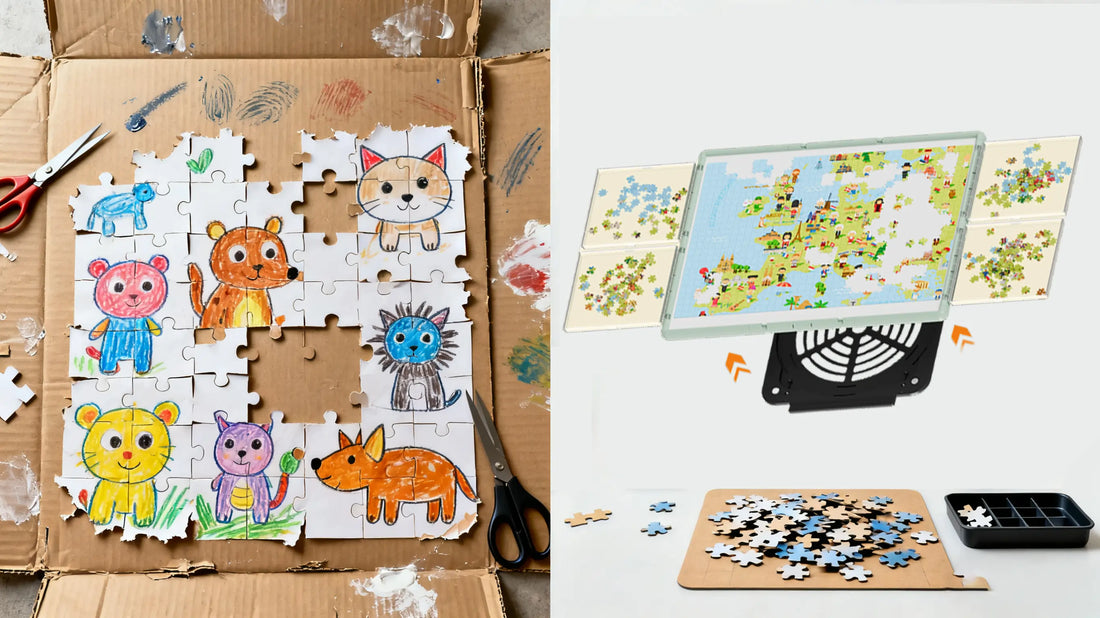
DIY Puzzle Boards vs. Store-Bought: Which One Fits You Best?
Share
Introduction
For puzzle lovers, the surface you use can make or break your puzzling experience. While some enthusiasts enjoy creating DIY puzzle boards, others prefer the convenience and durability of store-bought puzzle boards. Both options come with their own advantages and trade-offs. So, how do you know which one fits your lifestyle, budget, and puzzling style best?
In this article, we’ll break down the pros and cons of each, helping you make the right decision.
Table of Contents
1.What Are Puzzle Boards?
2.The Appeal of DIY Puzzle Boards
3.Downsides of DIY Puzzle Boards
4.Benefits of Store-Bought Puzzle Boards
5.Store-Bought Limitations
6.DIY vs. Store-Bought: Which One Fits You Best?
7.Tips for Choosing the Right Puzzle Board
8.Conclusion
9.FAQ
What Are Puzzle Boards?
Puzzle boards are portable surfaces designed to make puzzling more comfortable and organized. They provide a flat, stable area with features like sorting trays, covers, or even spinners to rotate the puzzle.
Depending on your needs, you can either build your own DIY puzzle board with simple materials or purchase a professionally designed board from a retailer.
The Appeal of DIY Puzzle Boards
Many puzzlers choose DIY boards because of their flexibility and affordability.
Cost Savings
A DIY puzzle board can be built with plywood, foam boards, or even old picture frames. This makes it a budget-friendly option, especially for those just starting out.
Customization
DIY allows you to tailor the board to your exact puzzle size. Whether you love 1000-piece or 2000-piece puzzles, you can adjust the dimensions to fit your needs.
Creative Satisfaction
There’s a special joy in crafting your own puzzle accessory. DIY puzzle boards let you merge creativity with functionality, making puzzling even more rewarding.
If you want step-by-step instructions, resources like WikiHow’s guide on making a puzzle board can be very helpful.
Downsides of DIY Puzzle Boards
While fun, DIY boards aren’t perfect:
Durability Issues: Homemade boards may warp, bend, or wear down quickly.
Limited Features: You won’t get professional add-ons like storage trays or spinners.
Time Investment: Building requires effort, tools, and a bit of trial and error.
Benefits of Store-Bought Puzzle Boards
If you want a reliable and professional puzzling experience, store-bought puzzle boards are hard to beat.
Durability and Quality
High-quality puzzle boards are designed to withstand long-term use. They’re often made with non-slip surfaces and sturdy frames that keep pieces in place.
Ergonomic Design
Some puzzle boards, like puzzle spinners, are engineered to reduce strain on your neck and back. This ensures hours of comfortable puzzling.
Our 2000-piece puzzle board is built for stability and comfort, perfect for large puzzles.
Time-Saving Convenience
No tools, no mistakes—store-bought boards are ready to use right out of the box. This is ideal for busy puzzlers who value their time.
Store-Bought Limitations
Of course, pre-made boards come at a higher price. Plus, you’re limited to the sizes and colors available from manufacturers. For some, this lack of personalization is a drawback compared to DIY.
DIY vs. Store-Bought: Which One Fits You Best?
Choose DIY if: You love hands-on projects, are on a budget, or want a fully customized size.
Choose Store-Bought if: You want durability, advanced features, or ergonomic design without the hassle.
Both options can enhance your puzzling journey—it really comes down to your priorities.
Tips for Choosing the Right Puzzle Board
1.Match Board to Puzzle Size: Whether it’s a 1000-piece or 2000-piece puzzle, make sure your board fits.
2.Consider Storage Needs: If you live in a small space, portability matters.
3.Think Long-Term: A store-bought board may save you money in the long run if you puzzle often.
👉 Explore our 1000-piece puzzle board collection for space-saving designs.
Conclusion
DIY puzzle boards bring creativity and affordability, while store-bought boards deliver convenience, quality, and ergonomics. The choice isn’t about right or wrong—it’s about what fits your puzzling lifestyle best.
Whichever you choose, the most important thing is to enjoy the journey of piecing together your favorite puzzles.
FAQ
Q1: What materials can I use for DIY puzzle boards?
A: Common options include plywood, foam board, and felt fabric.
Q2: Are DIY puzzle boards durable?
A: Not as durable as store-bought ones, but fine for light use.
Q3: Do store-bought puzzle boards work for large puzzles?
A: Yes, many are specifically designed for 1500–2000 piece puzzles.
Q4: Can I add storage trays to a DIY board?
A: Yes, but it requires extra materials and effort.
Q5: Which option is more ergonomic?
A: Store-bought boards with adjustable angles or spinners are much more ergonomic.
CTA
Ready to take your puzzling to the next level? 🎉
👉 Visit BJPuzT today and find the perfect puzzle board for your needs!
